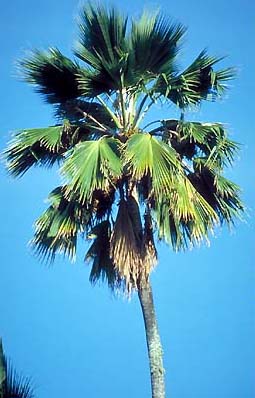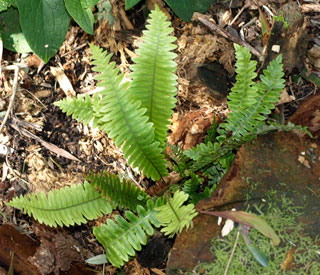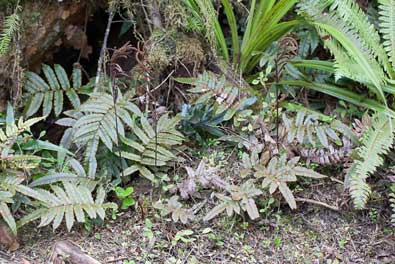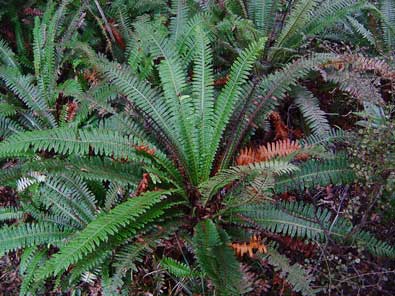 In many parts of the Pacific, a reflex of the original Proto Malayo Polynesian root word *biRu denotes one or more species of fan palm. The Māori reflex, a reduplicated form of the Proto-Polynesian root *piu (which elsewhere in Polynesia generally denotes the fan palm Pritchardia pacifica, illustrated on the left), is a term applied to four species of fern, three of which (Parablechnum procerum, Lomaria discolor, and Pakau pennigera) develop short trunks (up to a metre high in the case of P. pennigera), and the fourth (Parablechnum novaezelandiae) has a profusion of broad fronds which can reach up to 3 metres in length in ideal situations. In many parts of the Pacific, a reflex of the original Proto Malayo Polynesian root word *biRu denotes one or more species of fan palm. The Māori reflex, a reduplicated form of the Proto-Polynesian root *piu (which elsewhere in Polynesia generally denotes the fan palm Pritchardia pacifica, illustrated on the left), is a term applied to four species of fern, three of which (Parablechnum procerum, Lomaria discolor, and Pakau pennigera) develop short trunks (up to a metre high in the case of P. pennigera), and the fourth (Parablechnum novaezelandiae) has a profusion of broad fronds which can reach up to 3 metres in length in ideal situations.
While they share the designation of a single name inherited from earlier stages of the Polynesian language, each of these ferns is also known by other, locally developed names. The Parablechnum and Lomaria species are endemic to New Zealand; the Pakau is also found natively in Australia. Parablechnum novaezelandiae has the largest number of alternative names (perhaps reflecting its variability and tendency to hybridize with some other Parablechnum species): horokio, kiokio, korokio, koropiu (this incorporates the inherited root word), koropio, mokimoki, tupari and rautao; Lomaria discolor is also known as petipeti, tāniwhaniwha and turukio; Parablechnum procerum as kiokio (note the shared element, kio, in these sets of names); and Pakau pennigera as pākau and pākauroharoha.
 Lomaria discolor (illustrated below and to the right) is found throughout Aotearoa, especially carpeting the floor of beech forests. The tufts can be about 2 metres in diameter, and the trunks over a metre high. H.B. Dobbie (NZ Ferns, p. 306) describes it as "a gregarious species, often filling a glade to the exclusion of every other plant, and forming a picture hardly to be paralleled in the vegetable world." Lomaria discolor (illustrated below and to the right) is found throughout Aotearoa, especially carpeting the floor of beech forests. The tufts can be about 2 metres in diameter, and the trunks over a metre high. H.B. Dobbie (NZ Ferns, p. 306) describes it as "a gregarious species, often filling a glade to the exclusion of every other plant, and forming a picture hardly to be paralleled in the vegetable world."
Parablechnum procerum is also found throughout Aotearoa, often forming large patches in more open forest. Its fronds can be anything from 15cm to a metre long, depending on the habitat, with the stipes (bare stems) contibuting about a third of this length. The leaflets are in pairs, up to about 15 cm long by 3.5 cm wide, with rounded or pointed ends, and a single leaflet pointing lengthways at the apex of the frond; they taper only very slightly towards the base.
Parablechnum novaezelandiae, the "Palm-leaf fern" is like a giant version of P. procerum, with fronds up to 2.5 metres long, and also with fairly long stipes, but the leaflets taper towards the base of the lamina much more markedly than those of P. procerum. This fern is found throughout New Zealand, clothing roadside banks, and also steep gullies in forested areas. It thrives in damp. shady places, but establishes itself easily in drier, more open environments.
Pakau (formerly Pneumanopteris) pennigera can have a slender trunk up to a metre tall, with fronds up to 2 m. long and up to 40 cm. in the middle of the lamina (leafy section), tapering noticeably towards the top and base. The leaflets have conspicuous veins. It likes damp, heavily shaded areas along gullies. This species is found throughout Aotearoa and (unlike the others classified as piupiu), is also native to Australia.
How this name got to Aotearoa is uncertain; it does not seem to be present in other Eastern Polynesian languages, except for Tuamotuan, where it refers to the distinctly un-palm-like shrub Tournefotia argentea (see the page for Tauhinu for more on that plant). It is listed in the Pollex database as cognate but "borrowed", with no further explanation. The derivation does make sense, however, and provides another link to tropical Polynesia.
|
Photographs: The inset picture of a young plant of Lomaria discolor is from Te Māra Reo. That of the fan palm, Pritchardia pacifica, is by courtesy of Gerald McCormack (Cook Islands Natural History Project). The others were contributed by the NZPCN members acknowledged in the captions, and to whom we are most grateful.
Citation: This page may be cited as R. A. Benton (2022) “Piupiu [Māori]” (web page periodically updated), Te Māra Reo. "http://www.temarareo.org/TMR-Piupiu.html" (Date accessed)

Parablechnum procerum - Piupiu, Kiokio
(Growing in swampy ground.
Photo: (c) Mike Theisen, NZPCN.)
| 
Lomaria discolor - Piupiu, Petipeti
(Photo (c) Wayne Bennett, NZPCN.) |
|

